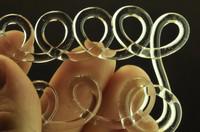 Since the Bronze Age, humans have
put to use the inherent compliance of liquids to shape matter and
construct objects. Metal casting, glass blowing, painting are all examples
of processes where a final construct is obtained following the solidification
of an initially liquid phase. Throughout history, this concept has matured
into a plethora of industrial processes, e.g. in the polymer industry.
Those engineering successes, however, come at the expense of simplicity.
Specifically, processes are generally largely tuned empirically with
compromises between versatility and reproducibility. I propose to explore
new paradigms in the design, the engineering, and the manufacturing of
structured and functional materials, using free surface gravity
driven flows, and harnessing their fluidic instabilities. Three examples
will be presented: (1) a fluid-instability based approach for digitally
fabricating geometrically complex uniformly sized structures in molten
glass, (2) the rapid fabrication of nearly uniform hemispherical elastic
shells by drainage and (3) their pneumatic actuation
towards shape morphing applications.
Since the Bronze Age, humans have
put to use the inherent compliance of liquids to shape matter and
construct objects. Metal casting, glass blowing, painting are all examples
of processes where a final construct is obtained following the solidification
of an initially liquid phase. Throughout history, this concept has matured
into a plethora of industrial processes, e.g. in the polymer industry.
Those engineering successes, however, come at the expense of simplicity.
Specifically, processes are generally largely tuned empirically with
compromises between versatility and reproducibility. I propose to explore
new paradigms in the design, the engineering, and the manufacturing of
structured and functional materials, using free surface gravity
driven flows, and harnessing their fluidic instabilities. Three examples
will be presented: (1) a fluid-instability based approach for digitally
fabricating geometrically complex uniformly sized structures in molten
glass, (2) the rapid fabrication of nearly uniform hemispherical elastic
shells by drainage and (3) their pneumatic actuation
towards shape morphing applications.
This Colloquium is jointly sponsored by Fields Institute for Research in Mathematical Sciences and the Department of Physics.

